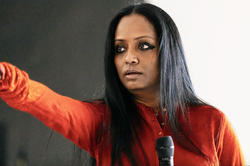A Wintersession elective taught by grad student Will Beattie helps students develop their own artistic voices.
RISD Students Paint Monumental Kaiju in Wintersession Studio

“The way you rendered the angels’ wings created these rhythms of color and light that really direct the eye,” says faculty member Mark Flores. He’s responding to a massive, homoerotic painting by first-year student Leo Chen 27 EFS in the Wintersession course he’s teaching in the Painting department: Painting Kaiju. The course title refers to the gigantic monsters created for Japanese sci-fi movies like Godzilla, but students are taking the opportunity to scale up all kinds of imagery during the five-week session.
“Painting Kaiju is intended to introduce students to a range of art-making technologies that physically expand the scale of their practice,” says Flores. “Most of the work is figurative, but some of the students are creating abstract pieces. I think a lot of them appreciate the opportunity to step away from their computers and paint on canvas.”
Sophomore Joshua Ehrlich 26 IL, an Illustration major, says that he normally works digitally or with graphite on paper, so the course is helping him “develop new tools and focus on scale as well as form. Experimenting in this studio has taught me a lot about how I work,” he adds.


Ehrlich presents two pieces at final crits, both black-and-white line drawings created with permanent ink, rather than paint. One of his peers describes his approach as “courageous” and notes that every creature in the undersea world he created seems to have “its own character, its own soul.” Another wonders what would happen if he tried using paint and experimenting with color.
Venezuelan native Ariana Chacon 26 ID used light and shadow to produce a powerful and cinematic portrayal of political unrest and human rights violations in the country where she was born. “I use art to channel my intense feelings about the student protestors who were tortured and murdered in 2017, after I moved to the US,” she says. “I still feel a lot of guilt for not being there with my cousins and friends.”
At the final review, one student notes that “the realistic, photographic quality of this painting is very effective.” Flores agrees, adding, “I like the combination of symbolic imagery and real-life moments. The viewer gets enough information to understand what’s happening without having everything spelled out for them.”


Junior Chase Burns 25 IL and sophomore Aisi Wei 26 IL both embraced the kaiju concept, painting colorful and fantastical creatures: Burns a robot inspired by 1970s Japanese cartoons and Wei a swirling dragon in celebration of the Lunar New Year. Burns describes his piece as “a metaphor for hope and optimism.”
The terrifying dog painted by fellow Illustration major Claire Sheih 25 IL serves as a darker metaphor. “It’s a dog but also a visualization of misplaced anger, especially among women,” the artist explains. “Making this piece is really helping me process my thoughts about femininity and restraint.”
The class is concurrently surveying moments in art history that approach the monumental, including the proliferation of large-scale murals created in the 1920s and ’30s by Mexican artists Diego Rivera and David Alfaro Siqueiros and more recent murals by Los Angeles-based activist and public artist Judy Baca. A quote from a reading by late abstract painter Mark Rothko sums up the studio vibe nicely: “I paint very large pictures,” he wrote. “To paint a small picture is to place yourself outside your experience, to look upon an experience… [through] a reducing glass. However, if you paint the larger picture, you are in it. It isn’t something you command.”
Simone Solondz / photos by Jo Sittenfeld MFA 08 PH
February 12, 2024


